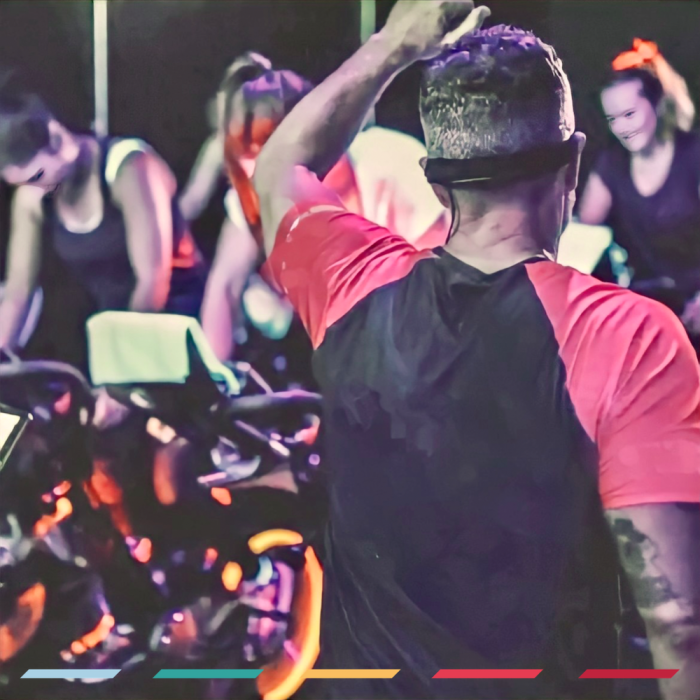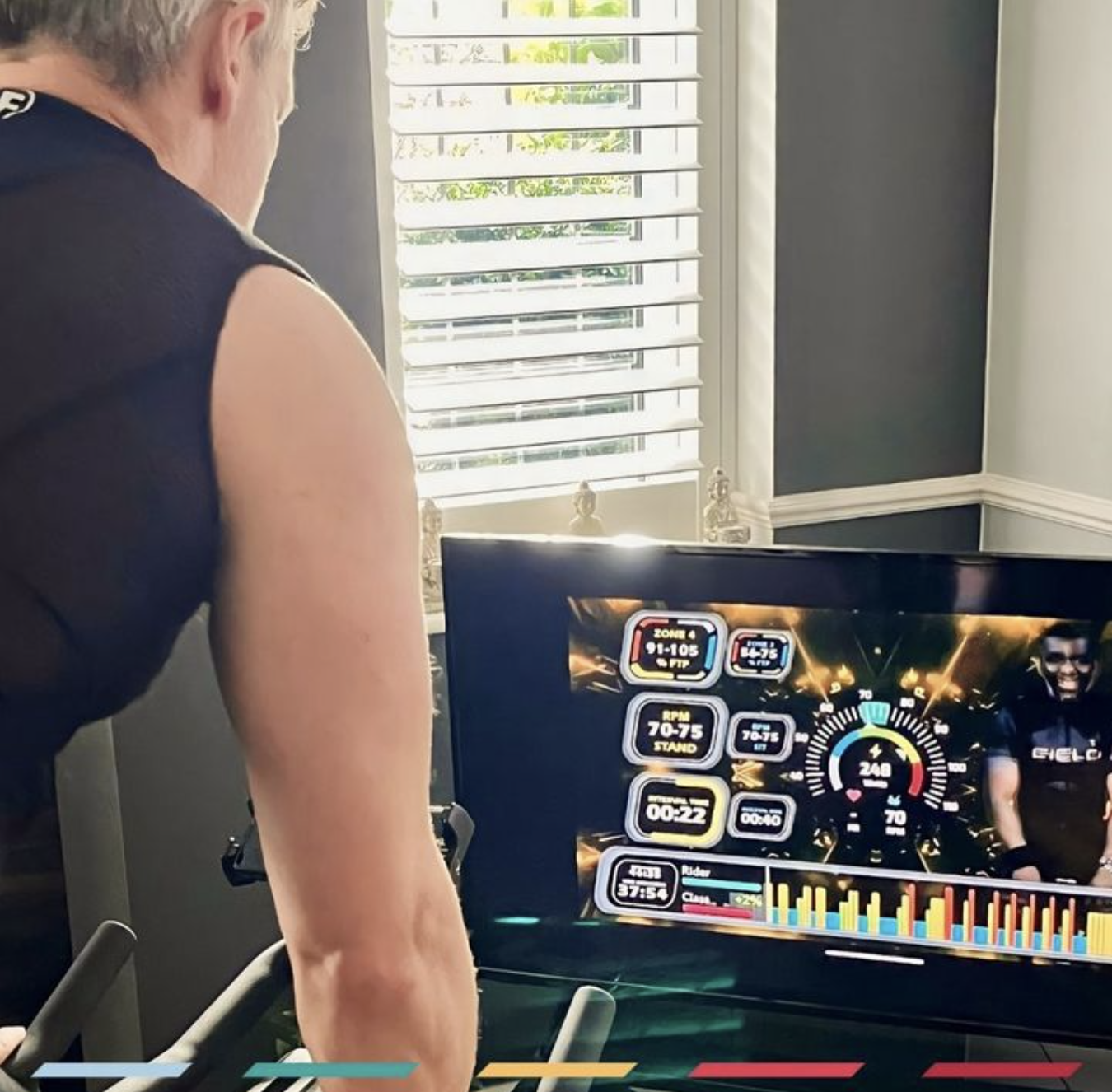There are a crazy number of ways that we are encouraged to get fit – from infomercials to celebrity endorsements, we are bombarded by the latest trends on a daily basis!
Just like fashion though, few of these trends stick around for too long… step aerobics classes from the 1980’s replaced by Zumba classes then Insanity and Metafit and Yoga giving ground to Pilates and then back again, as the media circus promotes the latest ‘in’ thing to keep our beach body in order.
One of the mainstays of group exercise though is the indoor cycling class. “Spinning,” developed by world-class cyclist Johnny G. in 1987, became the gold standard of indoor cycling, for one main reason. Now, to explain this we first need to look at the bike itself. For all intents and purposes a ‘Spin’ bike geometry and function is based on a traditional road bike, which was designed around the biomechanics of the human body, to make that body into the ultimate efficient movement machine. Therefore any movement undertaken on a ‘Spin’ bike must in some way replicate the movements a cyclist performs when riding his road bike because that cyclist has learnt how to move correctly to gain maximum results from riding with minimum risk to his or her body. Simply put, if you want to ride a bike indoors, then do it exactly as you would ride a bike outdoors and any person or platform chosen to teach you how to do this must have a background, understanding and education based on cycling in general. Lots of companies offer programs based on the “Spinning” model and have increased the availability and popularity of the classes. Keiser, Reebok, Schwinn, Stages – the longevity of these programs speaks to the fact that sticking to traditional cycling formats work, because they are super effective!
These programs were meant to replicate real cycling in an indoor setting, offering an opportunity to increase cardiovascular fitness, build strength, and burn calories at a high rate. As we have become smarter about the science of exercise, the classes have evolved. We have gone from high-speed peddling with little resistance and rapid jumps in and out of our saddles, to manoeuvres and speeds that are more realistic and comparable to “real” cycling.
So, here’s where the new trends come in – Peloton, Soul Cycle, Flywheel, to name a few. Fun? Sure. Intense? Positively! As human beings, we want something new, we strive to create things that are “more.” But some of the components of these new trends in indoor cycling are just plain dumb! (There, I said it!) A number of the “latest and greatest” of these celebrity-endorsed cycling programs include things like push-ups on the handlebars, lifting small dumbbells, and (don’t get me started) a move called a “tap back.”
Let’s start with the push-up, on the bike, while you’re sweaty, AND your legs are peddling. Seems like a trifecta of disaster, a real health hazard! Imagine yourself sitting basically upright on the seat of the bike – to strengthen your pecs (chest) in a push-up, the muscle fibres and where they attach should be close to parallel to the force against which you’re working. Gravity pulls straight down to the floor, so for a push up to be effective, you’d need to be facing the ground, but because you’re upright, there is very little resistance. So, to claim that this works to strengthen your upper body is nonsense! If your personal trainer is suggesting that you do pushups while sitting at your desk to build strength, run, don’t walk, to the exit of that gym and find someone new! Also remember that whilst trying to achieve this ‘Push-up’ your feet are clipped into pedals which in turn are attached to a heavy weighted fixed flywheel meaning your balance shifts on every rotation. It’s just nuts…… in fitness when exercising all trainers must run a risk to reward premise. A 60 year old man wanting simply to shift a few pounds and get a little fitter can achieve this with low to moderate intensity weight training and cardio which comes with very little physical risk, but if you want those Chris Hoy quads and booty then you are going to need to shift some serious weight on that squat rack and that extra weight comes with extra risk, but the payoff could be sooooo good!! it may be worth that risk. With this in mind, believe me, the reward for achieving a non weighted half movement press-up on the bike while you ride is definitely, I repeat 100% definitely not worth the risk.
Secondly, lifting a 1lb weight is not an upper body workout, unless you are very old, or working to rehab an injury—it will NOT make you stronger! One basic rule of exercise physiology is that you need to lift something that’s heavier than what you’re accustomed to lifting in order to see any gains in strength. If you’re toting a 15-pound purse around with you every day or lifting your toddler in and out of the car; you should be lifting more than a 1 or 2-pound dumbbell! So, rather than it being dangerous to lift a 1kg dumbbell on a bike its more honest just to admit to it being a complete waste of time and being stupid.
Right, hold on to your bib shorts because here is my third bug bear and its a cracker…The “tap back” could be compared to the rapid style repeated 4 or 8 count jumps that was done in the earliest stages of indoor cycling. You perform a kind of reverse jump, from standing, quickly tapping your glutes on the back of the saddle, and then rapidly return to standing. This is probably the most problematic move of all of the trendy new cycle programs, as it makes us rapidly decelerate the muscles of our back, and put undue stress on joints without any real benefits. Your knees and hips and low back take all of the force of the bouncing movement. The risk is much greater than any perceived benefit and we all know how I feel about the risk and reward theory. What makes it even more mind blowing to me is when I see these Pseudo ‘cycling’ classes incorporate the dreaded tap back, it’s normally while out of the saddle paddling with zero resistance at around 140 rpm. That, in itself, is a crime on its own which needs a lot more analysis than I’mm prepared to grant it on this blog… that will follow in a blog all of its own very shortly I’m sure.
Now… I’m pretty sure that any exponent of the ‘non traditional’ form of indoor cycling would hurl ‘it’s your opinion’ or ‘get with the new program Grandad’ comments at me and if my opinion was the only driving force behind my comments then their ‘opinions’ would be valid and I would accept them. Except they are not… and I won’t. The real, science-based answer is that if you could put a power meter on the bike (and many indoor bikes now come with meters) this lifting, pushing, tapping style of class necessarily reduces power output. These manoeuvres take power AWAY from the pedal stroke, and the pedal stroke takes AWAY from any upper body exercise you might perform. Will your heart rate be high? Absolutely! But high primarily due to the heat and humidity of the studio and all of those unnecessary gyrations on the bike. However, calorie burn is a result of power output, not how high your heart rate is, or how much you’re sweating. Science at work, again!! Power, Work, Joules of Energy and Calories are all linked inextricably and science beats fads everyday of the week, surely even instagram can’t be sooo influential that it can convince us that flicking your hair side to side while doing a press-up at 140rpm with a 4 count tapback set will burn more calories than a jump-set in your Tempo Zone 3 at 70 to 75 RPM…. can it? Well, not unless you are stupid maybe, or that you care more about likes and shares rather than your own health… or both?
In our quest to be trendy, new, and exciting, it’s important to keep effectiveness and safety first. So, my indoor cycling friends, don’t ride while also doing push-ups, lifting weights, or doing crunches to strengthen your core. Ultimately, you’ll end up doing a mediocre version of each exercise when you try to combine them on the bike. There is no nationally accredited indoor cycling certification program that teaches these moves. They are bio-mechanically unsound and produce no real physiological benefit.
Take a great, “real” indoor cycling class. Have fun, burn those calories, and take your strength training into the fitness center!! There is a bloody good reason why cycling is the worlds number one participation sport… because its frickin’ awesome…(when done right).




